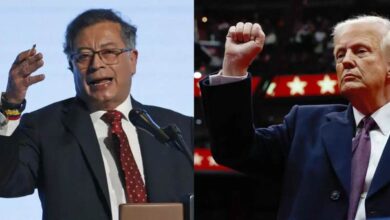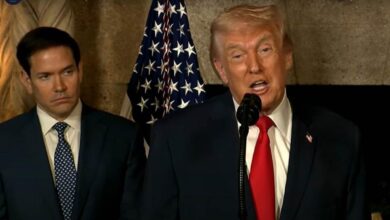The right in Latin America today is, to a large extent, opposition. What strategies or positions have they adopted in countries like Brazil, Colombia, Peru, or Bolivia? .

Photo: Antonio Cruz/Agência Brasil
LatinAmerican Post | Luisa Fernanda Sánchez
Listen to this article
Leer en español: La derecha en América Latina y su papel como oposición de gobierno
The victory of Luiz Inácio Lula da Silva in the presidential elections in Brazil pushed the country back to the left, highlighting a wave of victories in Latin America that little by little redirected it towards this model that, for many experts, would mean the return of the "pink tide": It recently happened in Colombia with the victory of Gustavo Petro, becoming the first president of the left, and it has remained in six of the seven largest countries in Latin America, such as Bolivia, with Luis Alberto Arce, and Peru with Pedro Castillo.
This is how the right has been simplified to an opposition role where it has had to demonstrate its ability to convoke to exercise political control on issues that today occupy the international agenda such as inflation, indebtedness and an unfavorable economy.
Also read:Daniel Ortega, the Great Dictator of Nicaragua Increasingly Powerful
Colombia Without a Visible Head of Opposition
For the right in Latin America, having a visible face that represents them has become the main slogan in the exercise of their work. However, not all have achieved them. This is the case of Colombia; the leaders of the political forces that are in disagreement with the guidelines and the political vision of Gustavo Petro, have not taken the baton as opposition and have been conspicuous by their absence.
In theory, the first option is former presidential candidate Rodolfo Hernández, who faced Petro in the second round. In accordance with the Opposition Statute, a 2018 law created for the opposition to have more strength and political presence gave the second most voted candidate the constitutional right to assume a seat in the Senate in order to give strength and visibility to a head of the opposition. However, Hernández renounced this right when he resigned from his position as senator to participate in the 2023 regional elections as a candidate for the Governor of Santander. A decision that resulted, both for its supporters and its detractors, in irreversible damage to its political structure as an opposition party.
Parties such as the Democratic Center have led batteries to question the government's measures, which is why they made their debut as opposition in recent demonstrations in various cities of the country. More than 9,000 protesters took to the streets of Bogotá and Medellín because they consider measures such as the tax reform and the agrarian reform in Colombia harmful to the people.
Far-right Models Predominate Without Being a Government
In Brazil, a far-right model of government led by Jair Bolsonaro (2019-2022) predominated for many years. After his defeat in the last presidential elections (October 2, 2022), there was a forceful brake on this model and the reactions did not wait. Once the results were known, demonstrators and supporters of "Bolsonarismo" came out to protest to demand a recount of votes and ignore the victory of Luis Inácio Lula da Silva as the new left-wing president. Now, as the opposition, the ultra-conservative force in Brazil is still taking advantage of its popularity to give the new government a political battle that, according to international analysts, is far from over.
The rise of Bolsonaro and “Bolsonarismo” have made the center-right or right-wing options practically disappear from the political spectrum in Brazil. That is why the new government will not have it easy at all, since the country now has a stronger parliament that is more inclined to the right. This is happening despite all the problems, mistakes, and criticisms during Jair Bolsonaro's term, due to the mismanagement of the pandemic and the ignorance of climate change and deforestation in the Amazon.
Something similar is happening with the president of Peru, Pedro Castillo, the socialist who came to power on July 28, 2021, with a speech demanding the most humble and disadvantaged sectors of society. Faced with the great expectations generated by his arrival at the Government Palace, the honeymoon did not last long. On more than one occasion and just months after he was sworn in, legislators from the right-wing Avanza País, Fuerza Popular, and Renovación Popular parties presented a petition to the Congress of that country to remove the leftist president from office, alleging his alleged “moral incapacity” to perform their functions.
Despite the fact that these three communities represent 55 of 130 in the Peruvian parliament, the impeachment request has not reached the number of votes needed to approve it. In other words, to remove a president in Peru, 87 votes are needed out of the total of 130 congressmen.
This is perhaps the fiercest opposition established in Latin America, given the constant fear of a possible dismissal of Pedro Castillo that has been around throughout his government. The marches that seek to put pressure on his departure are increasingly predominant, not counting the complaints made by the opposition for electoral fraud, questions, and criticisms of the lack of direction and ministerial crises. In just 120 days of management, a dozen ministers have changed and faces possible fractures in the government coalition. All this has made the president's disapproval rate exceed 59%, according to the latest Ipsos poll.
Concerns about the sustainability and representation capacity of the right in Latin America seem to have been transforming to exert an opposition in favor of the defense of conservative values and a model of governance that is still deeply rooted in the region.
The fact that a majority of Latin American nations are currently governed by leaders and political parties of the left does not imply that the right has become insignificant in electoral terms. In fact, in countries like Chile, Paraguay, or Mexico there are right-wing and center-right political parties that have not only reached important levels of parliamentary representation, but have also managed to win the Executive Power in the last decade.





